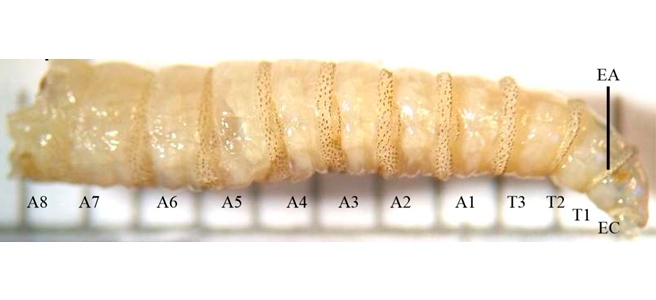

Study conducted at the Center for Research on Toxins, Immune Response and Cell Signaling (CeTICS) identifies, sequences and describes the structure of sarconesin, a peptide that eliminates various types of bacteria (photo: CeTICS)
Study conducted at the Center for Research on Toxins, Immune Response and Cell Signaling (CeTICS) identifies, sequences and describes the structure of sarconesin, a peptide that eliminates various types of bacteria.
Study conducted at the Center for Research on Toxins, Immune Response and Cell Signaling (CeTICS) identifies, sequences and describes the structure of sarconesin, a peptide that eliminates various types of bacteria.

Study conducted at the Center for Research on Toxins, Immune Response and Cell Signaling (CeTICS) identifies, sequences and describes the structure of sarconesin, a peptide that eliminates various types of bacteria (photo: CeTICS)
By José Tadeu Arantes | Agência FAPESP – An ordinary wound heals fairly quickly. Simply put, the healing process involves three stages: inflammation, cell proliferation, and remodeling. Chronic wounds get stuck in the inflammatory stage and fail to heal even in six months or more. Examples include diabetic foot ulcers, which often require amputation, and cutaneous leishmaniasis ulcers.
An ancient form of treatment for nonhealing wounds that was abandoned with the advent of antibiotics is being revived in hospitals in the United States, Europe and Latin America. In Brazil, it is used at the Onofre Lopes University Hospital in Natal, Rio Grande do Norte State.
Known as larval debridement or maggot therapy, the treatment entails the introduction of blowfly larvae into a nonhealing skin and soft tissue wound to debride (clean out) necrotic tissue, remove bacterial biofilm, and promote the growth of healthy tissue. While it may appear repulsive, maggot therapy has proved a highly effective method of healing recalcitrant wounds.
This is the focus for Andrea Diaz Roa, a PhD researcher affiliated with the Special Applied Toxinology Laboratory at the Center for Research on Toxins, Immune Response and Cell Signaling (CeTICS), one of the Research, Innovation and Dissemination Centers (RIDCs) funded by FAPESP. Diaz Roa is a native of Colombia and a postgraduate student in biomedical sciences at Universidad del Rosario in Bogotá. Her research at CeTICS is supervised by Pedro Ismael da Silva Jr., a scientific researcher with Butantan Institute in São Paulo, Brazil.
“She’s done groundbreaking, genuinely innovative work on the anti-bacterial peptide sarconesin produced by the larvae of the blowfly Sarconesiopsis magellanica,” Silva Jr. told Agência FAPESP. A paper on the subject was delivered to the 47th Annual Meeting of the Brazilian Society for Biochemistry & Molecular Biology (SBBq) held in May 2018 at Joinville, Santa Catarina State.
Diaz Roa was the first to identify, sequence and describe the structure of the peptide, which she called sarconesin after the blowfly Sarconesiopsis. The idea is to use the substance as the active ingredient of a drug. Because it is a relatively small molecule, sarconesin can be synthesized in the laboratory by a totally artificial process. It can also be genetically engineered by introducing the DNA base pairs that encode it into a host bacterium.
“We know its amino acid sequence, and we’ve evaluated its anti-microbial activity in connection with various bacteria. We’re thinking of applying for a patent,” Silva Jr. said.
Anti-microbial peptides usually disrupt the membranes of invading pathogens. Their action is purely electrostatic. The membranes are electrically negative, and the peptides are electrically positive. Once they are attracted to invading bacteria, the peptides stick to their membranes and tear off pieces. The contents of the bacteria leak out through the holes, and they eventually die.
“This isn’t the case with sarconesin,” Silva Jr. said. “We know it’s electrically neutral. Our hypothesis is that it’s somehow internalized by microorganisms and destroys them from the inside by deconstructing their DNA or RNA. We’re still investigating the mechanism.”
Diaz Roa said she is approaching the matter in two ways. One consists of making sarconesin into a drug without maggot therapy. The other aims to introduce maggot therapy to Brazil.
She recently went to the US to visit the laboratory headed by Ronald Sherman, considered the “father” of modern maggot therapy. She now plans to settle in Brazil and apply this medical procedure here.
“The flies are bred in the lab and lay their eggs in organic matter,” Diaz Roa explained. “Sterile larvae are placed inside the wound, remaining there for 24 to 48 hours. Twenty per square centimeter are used on average. The wound is covered during the procedure and cleansed after removal of the larvae. A single application may be sufficient, depending on the case. They feed only on the necrotic tissue in the wound.”
Leaving aside the repugnance maggot therapy may arouse, the procedure causes no more discomfort than the wound. Most chronic wounds itch, ache and/or ooze.
In the case of diabetic foot ulcers, the patient may feel no discomfort because of the numbness often caused by the disease, and maggot therapy alone can be enough to heal these ulcers completely.
In the case of cutaneous leishmaniasis ulcers, maggot therapy provides only adjunctive care, since their recalcitrance results from the active presence of the Leishmania parasite, which inflames the site. Primary treatment in this case consists of killing the parasite with highly toxic drugs controlled by public health surveillance agencies. The role of maggot therapy will be to promote wound healing after removal of the parasite.
Republish
The Agency FAPESP licenses news via Creative Commons (CC-BY-NC-ND) so that they can be republished free of charge and in a simple way by other digital or printed vehicles. Agência FAPESP must be credited as the source of the content being republished and the name of the reporter (if any) must be attributed. Using the HMTL button below allows compliance with these rules, detailed in Digital Republishing Policy FAPESP.





